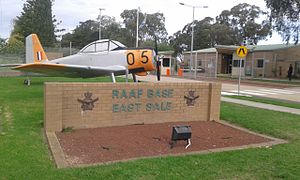
The Roulettes are the Royal Australian Air Force's formation aerobatic display team. They provide about 150 flying displays a year, in Australia and in friendly countries around the Southeast Asian region. The Roulettes form part of the RAAF Central Flying School (CFS) at RAAF Base East Sale, Victoria.

The Aermacchi or Macchi MB-326 is a light military jet trainer designed and produced by the Italian aircraft manufacter Aermacchi. It is one of the most commercially successful aircraft of its type, being bought by more than 10 countries and produced under licence in Australia, Brazil and South Africa.
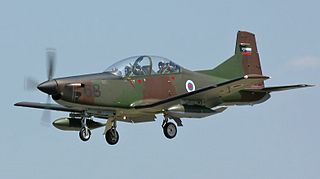
The Pilatus PC-9 is a single-engine, low-wing tandem-seat turboprop training aircraft manufactured by Pilatus Aircraft of Switzerland. Designed as a more powerful evolution of the Pilatus PC-7, the PC-9's first flight was made in May 1984 after which certification was achieved in September 1985. After this, the first production orders for the type were received from the Royal Saudi Air Force, with deliveries commencing in 1985. Since then, more than 250 airframes have been produced across five different variants, and the type is employed by a number of military and civilian operators around the world, including the Swiss Air Force, Croatian Air Force, Royal Thai Air Force and the Irish Air Corps

The Pilatus PC-21 is a turboprop-powered advanced trainer with a stepped tandem cockpit. It is manufactured by Pilatus Aircraft of Switzerland.
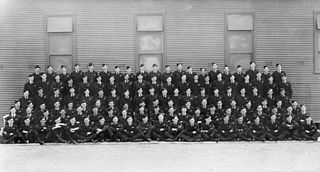
No. 1 Operational Training Unit (No. 1 OTU) was an operational conversion unit of the Royal Australian Air Force (RAAF) during World War II. Formed in December 1941 at Nhill, Victoria, it relocated to Bairnsdale in mid-1942, and then to East Sale the following year. No. 1 OTU's primary role was to train aircrew for multi-engined aircraft operations. At its peak of activity in August 1944, it was operating over 130 aircraft, the most numerous being Bristol Beauforts. Its aircraft and personnel also conducted transport missions in New Guinea and maritime patrols in southern Australian waters. Following the end of hostilities, the unit was disbanded in December 1945.
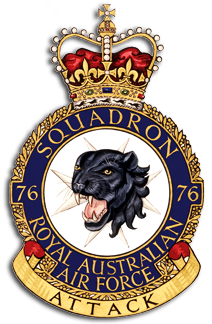
No. 76 Squadron is a Royal Australian Air Force (RAAF) flight training squadron. Established in 1942, it operated P-40 Kittyhawk fighter aircraft in the South West Pacific theatre during World War II. Following the end of hostilities it re-equipped with P-51 Mustangs and formed part of Australia's contribution to the occupation of Japan until disbanding in 1948. The squadron was re-formed in 1949 and three years later transferred to Malta, where it operated de Havilland Vampire jet fighters on garrison duty until again disbanding in 1955. It was reactivated in 1960 and operated CAC Sabre and Dassault Mirage III fighters in Australia until 1973. No. 76 Squadron was re-formed in its present incarnation in 1989 and is currently stationed at RAAF Base Williamtown, New South Wales, where it operates Hawk 127 jet training aircraft.
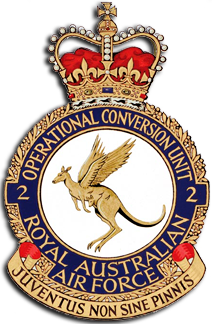
No. 2 Operational Conversion Unit is a fighter training unit of the Royal Australian Air Force (RAAF). Located at RAAF Base Williamtown, New South Wales, the unit trains pilots to operate the Lockheed Martin F-35 Lightning II. Pilots new to the F-35 enter No. 2 2OCU after first qualifying to fly fast jets at No. 79 Squadron and undertaking initial fighter combat instruction at No. 76 Squadron. Once qualified on the F-35, they are posted to one of No. 81 Wing's operational Hornet units, No. 3 Squadron, No. 75 Squadron or No. 77 Squadron.

No. 2 Flying Training School is the main flying training school of the Royal Australian Air Force (RAAF). Formed under its present name in 1969, it is located at RAAF Base Pearce, Western Australia. The unit operates a fleet of Pilatus PC-21 turboprop trainers. No. 2 FTS traces its origins to the post-war re-establishment of the Air Force's original cadet training unit, No. 1 Flying Training School, at RAAF Point Cook, Victoria, in 1947. Following reorganisation of aircrew training in 1951–52, No. 1 FTS was renamed No. 1 Applied Flying Training School, and began specialising in advanced flight instruction on CAC Wirraways. It relocated to RAAF Base Pearce in 1958, where it converted to De Havilland Vampire jet trainers. In January 1969, the school was reformed as No. 2 FTS, having the previous year begun replacing the Vampires with Macchi MB-326Hs. The Macchis were themselves replaced by the PC-9 beginning in 1989.
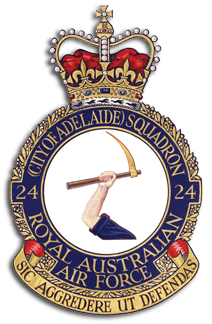
No. 24 Squadron is a Royal Australian Air Force squadron. The squadron was formed in 1940 and saw action as a bomber squadron during World War II serving in the Pacific theatre against the Japanese, and undertaking operations during the Battle of Rabaul, and the New Guinea, New Britain and Borneo campaigns. The squadron was disbanded in 1946 following the conclusion of hostilities, but was re-formed in 1951. From then until 2010 the squadron was an RAAF Reserve squadron located near Adelaide, South Australia; for part of this time, until 1960, the squadron continued to perform flying duties, before converting to a ground support role. In 2010, the squadron combined with Combat Support Unit Edinburgh to become a Permanent Air Force unit and it currently forms part of No. 96 Wing, Combat Support Group.

The CAC CA-25 Winjeel is an Australian-designed and manufactured three-seat training aircraft. Entering service with the Royal Australian Air Force (RAAF) in 1955 as a basic to advanced trainer, it served in this role until 1975. Later, it was used in the Forward Air Control (FAC) role for target marking until 1994, after which it was retired from RAAF service.

Air Force Training Group is the Royal Australian Air Force (RAAF) group responsible for training personnel. It is headquartered at RAAF Williams, Victoria. The group was established as Training Command in 1953. It formed part of Support Command between from 1959 to 1990, when it was re-established as Training Command. In July 2006, Training Command was re-formed as Air Force Training Group under Air Command. Air Force Training Group consists of a headquarters and two Academies: Air Academy and Ground Academy.

Central Flying School (CFS) is a Royal Australian Air Force (RAAF) training unit, located at RAAF Base East Sale, Victoria. It operates the Pilatus PC-21 turboprop trainer. The school is responsible for training flight instructors, setting flying standards, and auditing flying practices. It is also home to the "Roulettes" aerobatic team. CFS was the first military aviation unit to be formed in Australia, in 1913, when its role was to provide basic flying training. Its current form dates from World War II, when it was re-established to train flying instructors for the Empire Air Training Scheme (EATS).
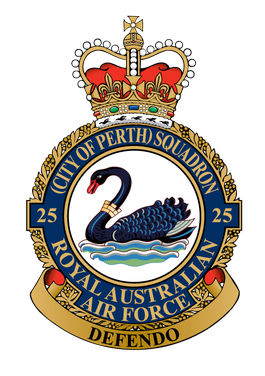
No. 25 Squadron is a general reserve squadron of the Royal Australian Air Force (RAAF). It is based at RAAF Base Pearce in Perth, Western Australia, and forms part of the Combat Support Group. The squadron was formed in early 1937 and until early 1939 was designated as No. 23 Squadron. During World War II, it provided local air defence for the Perth region, before undertaking Army co-operation duties in 1943–1944 and then converting to a heavy bomber role in 1945. Flying B-24 Liberators, the squadron took part in operations against Japanese targets in the Netherlands East Indies (NEI) and supported Allied ground operations during the Borneo Campaign.

No. 5 Operational Training Unit was an operational training unit (OTU) of the Royal Australian Air Force. It was formed at Wagga Wagga, New South Wales, in October 1942 to train pilots and navigators for service in World War II. The unit was initially equipped with Bristol Beauforts and Beaufighters, and later received Douglas Bostons and de Havilland Mosquitos, among other types. No. 5 OTU was transferred to Tocumwal in October 1943, and then to Williamtown in mid-1944. It was reorganised as a fighter conversion unit flying P-51 Mustangs and CAC Wirraways in February 1946, and disbanded in July 1947.
724 Squadron was a Royal Navy Fleet Air Arm and Royal Australian Navy Fleet Air Arm flying squadron. The squadron was formed for the first time in 1945 and was last disbanded in 1984.

The Australian Defence Force Basic Flying Training School (BFTS) was located in Tamworth in northern New South Wales. It was run by BAE Systems Flying Training Academy, which conducted tri-service flight screening and basic flying training for the Australian Defence Force (ADF) aircrew from the Australian Army, Royal Australian Navy (RAN) and the Royal Australian Air Force (RAAF) using CT-4 Airtrainer aircraft. It helped pilots gain basic knowledge about flying, it also had a 26 week basic flying simulation course.
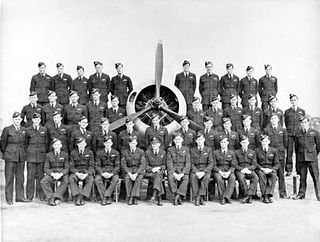
No. 5 Service Flying Training School was a Royal Australian Air Force (RAAF) flight training unit that operated during World War II. It was one of eight Service Flying Training Schools established by the RAAF to provide intermediate and advanced flying instruction to new pilots as part of Australia's contribution to the Empire Air Training Scheme. No. 5 SFTS was formed at RAAF Station Uranquinty, New South Wales, in October 1941, and disbanded in February 1946. Its staff and equipment were employed to re-establish No. 1 Flying Training School, which transferred to RAAF Station Point Cook, Victoria, the following year. Care and Maintenance Unit Uranquinty was also formed from No. 5 SFTS's facilities, to look after surplus aircraft at the base prior to their disposal, and disbanded in December 1948.
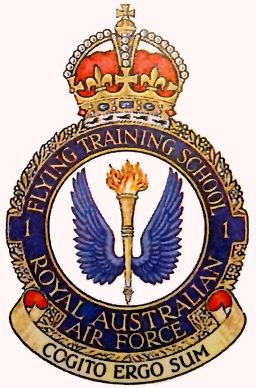
No. 1 Flying Training School is a school of the Royal Australian Air Force (RAAF). It is one of the Air Force's original units, dating back to the service's formation in 1921, when it was established at RAAF Point Cook, Victoria. By the early 1930s, the school comprised training, fighter, and seaplane components. It was re-formed several times in the ensuing years, initially as No. 1 Service Flying Training School in 1940, under the wartime Empire Air Training Scheme. After graduating nearly 3,000 pilots, No. 1 SFTS was disbanded in late 1944, when there was no further requirement to train Australian aircrew for service in Europe.

The Alap-Alap Formation is the official aerobatic display team of Brunei Darussalam, operated by the Royal Brunei Air Force. The Alap-Alap Formation display team was formed on 7 February 2011.
Douglas Walter Leckie, was an officer in the Royal Australian Air Force who served as Commanding Officer Antarctic Flight RAAF, which assisted the Australian National Antarctic Research Expedition (ANARE) in 1954, 1956 and 1959.
